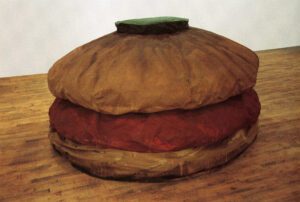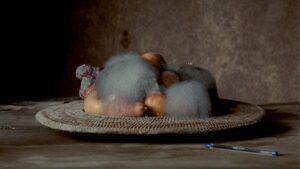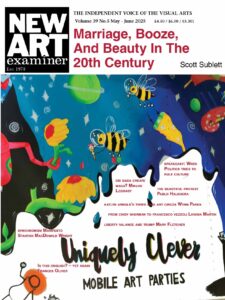
Claes Oldenburg, Floor Burger, 1962, canvas, foam rubber, cardboard, acrylic paint
Darren Jones
In the crucible of contemporary art one could be forgiven for thinking that pluralism regarding taste has gone missing. It’s as though it’s been kidnapped from public access and relocated within the jurisdiction of a minority of stakeholders to control what is (and isn’t) deemed important art. The coup d’état has been so successful that one can even be discouraged from trusting the validity of one’s own sensibilities. This ensures that hand-picked artists – the coat-hangers of history – meet little resistance en-route to their preeminent positions. If enough effort and money are invested, an artist might reach that critical mass of exhibitions, press, celebrity (notoriety) and sales beyond which critical dissent becomes futile.
The hierarchy is nearly impregnable. Even after artists cease to contribute meaningfully they continue to be propped-up. That moment of implosion is sometimes detectable – Marina Abramović’s disastrous tango (and tangle) with Jay-Z; and Ai Weiwei’s unnecessary and grotesque re-staging of Nilüfer Demir’s viral photograph showing the dead body of three-year-old Syrian migrant, Alan Kurdi, are exemplary.

Declines can also be slower as artists petrify in the acts that made them. Richard Prince’s tedious thievery of other peoples’ images, and Sarah Lucas still beating the meat, eggs and dead horses are two instances. Similarly, Rachel Whiteread has entombed herself in House, the full-scale cast-sculpture (the title is literal) that won her the 1993 Turner Prize and on the same night, the K Foundation Award for Worst British Artist. Her endless spatial castings are echoes of that early work, so it’s fitting that the polemics of artistic worth have rarely been addressed as spectacularly as that astonishing incident. The K Foundation’s £40,000 award (twice the Turner’s check) was funded by Bill Drummond and Jimmy Cauty of the electronic, Hip hop-inspired band The KLF. Their purpose – via iconoclastic advertisements, actions and installations — was to undermine existing art world structures, and through intervention and insurrection initiate “the amending of art history.” The unflattering award was presented to Whiteread outside Tate Britain where the Turner Prize ceremony had just taken place. Unwilling to accept the dubious accolade she was informed that if she didn’t the K Foundation would burn the money. What would you have done?
It’s not to say that any given artist is undeserving of a successful career, or that gallerists don’t believe fully in the artists they choose to promote—in fact, to put that much faith into an artist, they must. It is to say that usually one artist is not more deserving than tens of thousands of others. What makes the difference is the investor’s (gallery’s or institution’s) ability to convince the art world, then inform (never ask) the public. Nepotism and cultural tectonics can also help. But typically the gallerist must also be an alchemist who turns base opinion into fact – an unenviable and often frustrating task that requires subverting the truth that everyone’s taste is equal.
The architecture of larger gallery conglomerates is contrived to aid that process by impressing reverence and awe upon the visitor. To enter a hushed gallery is to leave behind one’s physical relationship to casual surroundings on the street and enter a highly controlled environment that makes us excruciatingly aware of our bodies and movements. Often there will be no greeting, even if someone is sitting at the front desk. This is not welcoming, but not terribly unwelcoming—it’s slyly disorienting. There is usually nowhere to sit, so we must stand, and how to stand before art can be fraught and awkward. Further, the lighting isn’t designed for people; it’s there to glorify objects, and we can feel awfully exposed and vulnerable under the harsh glare when alone in a stark room.
These settings are so arresting that if we speak we whisper. The atmospherics literally silence us. If you cannot talk you cannot disagree. Try speaking very loudly next time. It’s a small act of disobedience but it’s wonderfully liberating because it breaks the electrical current on the gallery’s invisible dog fence. If you feel rude, disruptive or out of place, you’re supposed to. These characteristics might cow even seasoned visitors and they would probably overwhelm the uninitiated – the public that the system so often claims to challenge or question but usually ignores because it has no interest in discussing its differing opinions. The intention of galleries is similar to that of churches—those Wendy houses of mendacity. They sell products and they don’t appreciate scrutiny of their imprimatur. Interestingly, the homograph ‘curate’ refers to both organizing an exhibition and to a member of the clergy.
Knowing the etiquette and submitting to what you’re told is tasteful is the entry fee to these showrooms. If the codes weren’t imposed, the visitor might

realize that these hot new artists, groundbreaking art and “must-see” exhibitions are often borrowed from the emperor’s closet.
The language of art is also employed to discourage mutiny. The solemn tones of press releases, catalog essays, panel discussions and curatorial statements are pitched to buttress the rightness, even nobility, of the gallery’s choice. Claims are staked and positions defended so imperiously that the status quo hardens. Even in casual discussion the prevailing narrative of what constitutes proper art is vigorously protected.
Some years ago, at a smart New York art gathering while talking with a philosopher, a critic and a historian, this writer witnessed a most shocking blast of critical napalm – for the crime of aesthetic sedition. The critic expressed his enjoyment of Thomas Kinkade’s paintings. “Why?” asked the incredulous historian.
“Because his bucolic scenes are redolent of the timeless, arcadian environments of my rural upbringing; and of time spent exploring forests and mountains as an adolescent wanderer. Because his vignettes are so removed from the relentless technology that dominates our lives. The contentment, solitude and union with the natural world are so alluring. And because it is tantalizing to think about stepping into his paintings and venturing towards those distant peach-crimson horizons.”
“Then you are an idiot!” the historian replied, followed by a lecture that the critic was failing to do as critics must – educate the public in what the historian considered the correct taste, the right art, because “the masses need to be told what to like.” An argument ensued over what was the greater threat to the public’s trust in contemporary art – the historian’s dogmatism or the critic’s supposed naiveté.

There, in the citadel of artistic ratification, a distinguished academician’s withering authoritarianism functioned as censure upon someone who strayed from the carefully written script of history. But perhaps what he actually felt was concern, even fear – that dissent, if permitted might undermine the canonical apparatus and with it his position and privilege. Socratic argument and counter argument – the engine of modernity – may be dead in the art world.
Instinctive connection with a work of art can be a profound experience; it is the greatest treasure that art can offer and it’s necessarily a rare occurrence. Ridiculing that is an elitist act intended to humiliate, and to extinguish a person’s spiritual union with what they find beautiful and resonant. In our example, the critic was equipped to defend himself, but how would someone outside the art world visiting a museum or gallery assert his dislike of the art within, or indeed his own taste? Would he have the opportunity or the confidence? Who would even listen? As audiences largely acquiesce to the presumption that if it is in a great museum then it must be great art, the timeline of art continues unchallenged. But if that conceit isn’t argued down, the machine, and the public it claims to serve, are not connected, but kept apart by the former’s proclamations and the latter’s shrugging acceptance.

There’s an irony in the horror that Thomas Kinkade and his ilk incite within the intelligentsia – the populist appeal; the factory production; the cynical commercial grab; and the kitsch, gaudy imagery. But that could equally describe the work of artists who are firmly entrenched within the structure – Jeff Koons, Brian Donnelly or Gilbert & George – and whose auction hauls outstrip their meagre talents, bankrupting the concept of artistic innovation. Hypocrisy is key. Financial plundering is fine as long as it’s presented in limited editions at Sotheby’s and not en-masse in shopping malls. If the product comes with scholarly license—and even better, Alice in Wonderland scale, bright metallic colors and a Disney sense of “play” —almost any object can be made to seem appealing however stupid it may be. Academia is one of the foundation pillars of art as only another stream of market economics.
In conversations about contemporary art between those who make it, sell it, exhibit it, deal in it, study it, write about it, or buy it, taste is only ever referred to as singular. There are never tastes. The implication is that there’s really only one. It’s a subtle but dominant detail about the art ecosystem’s appetites, and a corruption of why artists exist at all.
Darren Jones is a Scottish art critic, based in the United States.
Volume 35 no 4 March/April 2021


well gosh!…. what does this all mean ????….. have we created a new freedom to actually address what art may be if…IF we speak up????
Duchamp in a 1968 BBC interview with Joan Bakewell,available on youtube, said that he had tried to discredit art, to get rid of art the way some people got rid of religion. His statement that “good taste is the enemy of art”, while untrue, was part of that effort to discredit art. Neuroscientist Antonio Damasio’s study of non-verbal language says that “every perceptual experience is accompanied by emotional coloration – an evaluation of subtle shades of good or bad, painful or pleasurable, a spectrum of cognitive and emotional memories, providing an instant valuation…taste is a cultural adaptation of great significance.”